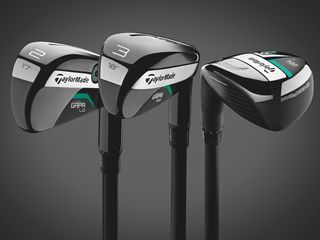What are the right 14 clubs for you?

As you improve at golf, it is easy to focus on technique without looking for the simplest clues to unlock the easiest improvements. That is why it is important to ask what are the right 14 clubs for you?
How often do you scrutinise your own game? Do you ever take a moment to look back on a round and think about where your successes and failures have come from? Do you have a consistent miss? Do you know how far you hit the ball? As you attempt to improve at golf, it is all too easy to focus on technique without looking for the simplest clues to unlock the easiest improvements. That is why it is important for every player to question – what are the right 14 clubs for you?
Every golfer will carry a driver and a putter so that leaves 12 places up for grabs and the truth is that no two golfers will have the same exact set composition. In answering the question – what are the right 14 clubs for you – you’ll need to focus on the following areas:
1 Close The Gaps
The biggest equipment mistake you can make is to have two clubs in your bag that go the same distance. For many amateurs this happens when they progress into their long irons. For slow and medium swing speed players there comes a point of diminishing return, when less loft does not deliver more distance. This means that for a lot of amateurs, their 6-iron goes the same distance as their 5-iron. Avoiding this in your own game is a must. However, just because you can’t get the performance you need from your set 5 or 4-iron doesn’t mean there isn’t a club out there for you. If you fall into this category, as many amateurs do, moving into hybrids and then fairway woods is definitely the way to go. Ideally, you should be looking for around 10-yards between clubs at the bottom end of your bag and 15-yard gaps at the top end. Anything less than this and some tweaks to your set up are needed!

2 Dial Yourself In
The best way to work out your composition at the top end of the bag is through a good custom fitting with a qualified PGA Professional, preferably using a launch monitor. This way you will be able to get exact feedback on how far each club is going. With instant feedback from the data and with a guiding hand from an expert, you will quickly understand how different lofts, head designs and shafts will affect your distance numbers. Do not worry about what is written on the bottom of the club – the only thing that matters is that you have even distance gaps between your clubs. A thorough fitting alongside PGA pro will give you the opportunity to test a range of options for yourself. While you might already have an idea of what combination might be best for you, getting the exact specification spot on is essential. If you can dial yourself in, your game will improve immediately.
Get the Golf Monthly Newsletter
Subscribe to the Golf Monthly newsletter to stay up to date with all the latest tour news, equipment news, reviews, head-to-heads and buyer’s guides from our team of experienced experts.

3 Confidence Is Key
Every golfer is different. What fits your eye and gives you confidence will make another golfer uncomfortable and nervous. That’s why the manufacturers have a range of different options to choose from, especially at the top end of the bag. From relatively traditional-looking long iron replacements to compact hybrids into bigger hybrids and fairway woods, the options are vast. Do not buy anything that doesn’t fit your eye – it will only end up becoming redundant ‘bag furniture.’ If you get the shaft and loft right, you can get any modern club, designed for the top end of the bag, to fit neatly into your set.
Latest Gear: TaylorMade GAPR Range Revealed
4 Wedge Focus
Once you’ve worked out the top end of your bag, you will then know how many places you have to fill at the bottom end. As an example, and for the sake of this article, we will presume your highest lofted iron is the set pitching wedge and that you hit this 120-yards. We will also presume that you have a favourite loft for greenside bunker and basic chip shots – let’s say that is 60˚. There is naturally going to be a sizeable gap between your 120-yard set wedge and your maximum 60˚ wedge pitching distance. This is the gap you now need to focus on.
5 Your Shot Saver
One of the most important clubs in the bag is your most lofted wedge. From flop shots and bunker shots to basic chips, a normal round of golf will place a host of demands on this club. That’s why it is crucial to choose a lofted wedge that allows you to hit a host of different shots. When you are testing different options do not make the mistake of hitting the same shot over and again. Lean towards a model with good versatility, like the TaylorMade Milled Grind Hi Toe and then do some testing to see how it works in a range of positions. That way you’ll end up with an option to help you save your score no matter where you miss the green.

6 Necessary Compromises
With only 14 clubs at your disposal, there are likely to be certain areas within your line-up where the gaps are bigger than you ideally want. Whether this is at the top or bottom end of your bag is up to you - Rory McIlroy explains his approach here. If you’re unsure, our advice would be to play to your weaknesses. If your wedge game is weaker than your long game, put an extra wedge in the bag. You will be better placed to make the manipulations you need to hit different distances in the area of the game you are strongest. When answering the question - what are the right 14 clubs for you? - an extra addition in the area you are weakest might help you make a significant improvement to your game.
Articles created in partnership with TaylorMade.
-
 Valero Texas Open Prize Money Payout 2025
Valero Texas Open Prize Money Payout 2025Akshay Bhatia defends his title as players compete in the final PGA Tour event before The Masters
By Mike Hall Published
-
 I've Played Both World-Class Links And Delightful Hidden Secrets Along Ireland's Wild Atlantic Way...
I've Played Both World-Class Links And Delightful Hidden Secrets Along Ireland's Wild Atlantic Way...Kevin Markham highlights the golfing adventure that is west Ireland's spectacular Wild Atlantic Way
By Kevin Markham Published